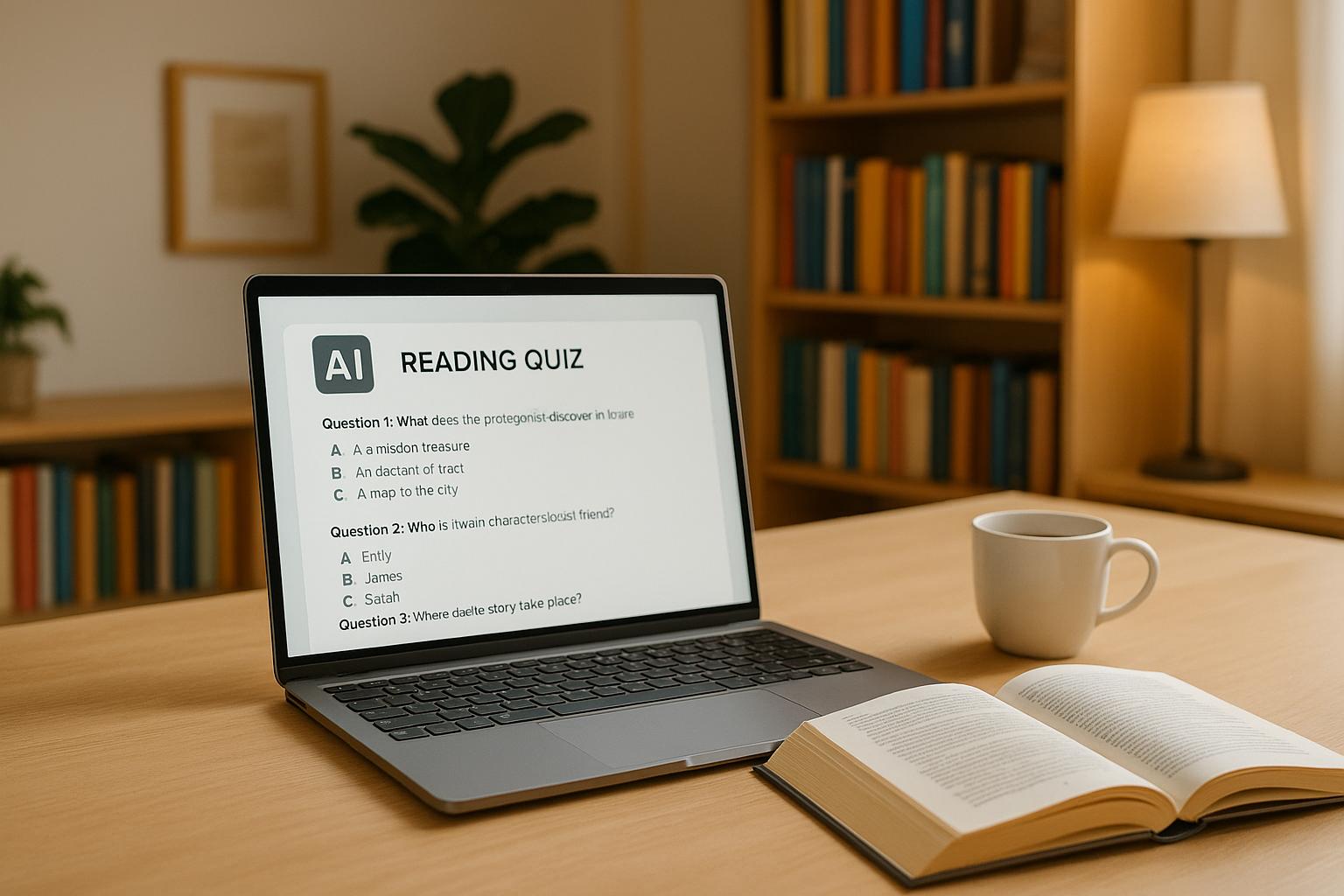Creating reading quizzes has historically been a time-consuming task for educators. However, AI tools now make it faster and easier to generate quizzes that assess comprehension and critical thinking. These tools can create personalised quizzes in seconds, saving hours of manual effort. They support multiple question types, adapt to different skill levels, and even work in multiple languages. For instance, platforms like Testudy.io allow educators to upload text, set learning goals, and generate quizzes tailored to their students’ needs.
Key Points:
- Why Reading Quizzes Matter: They help identify learning gaps, improve focus, and track progress.
- How AI Helps: AI generates questions quickly, adjusts difficulty, and supports diverse question formats.
- Steps to Create Quizzes:
- Upload or select text.
- Set learning objectives.
- Generate and review questions.
- Benefits: Saves time, offers instant feedback, and supports multilingual classrooms.
- Challenges: Requires teacher review to ensure quality and relevance.
AI tools like Testudy.io simplify quiz creation, but they work best when combined with a teacher’s expertise to refine and personalise the content.
Make Google Quizzes With Free AI Tool. Perfect for Teachers
Key Features of AI Tools for Quiz Creation
When choosing an AI tool for creating reading quizzes, certain features can elevate a simple test into a meaningful learning experience. The best platforms blend flexibility and customisation to help both educators and students reach their objectives.
Support for Multiple Question Types
AI tools bring a wide variety of question formats to the table, making it possible to assess a range of comprehension skills. These include multiple-choice, fill-in-the-blank, true/false, short-answer, and open-ended questions. This diversity ensures quizzes aren’t just routine but can challenge different levels of understanding and critical thinking.
Some tools even offer specialised options, like vocabulary quizzes where questions are presented in one language and answers are expected in another. Others generate fill-in-the-blank exercises within a single language. Advanced platforms take it a step further by aligning questions with educational standards, such as Bloom’s Taxonomy levels or Depth of Knowledge (DOK) frameworks. For language learners, these tools can create a balanced mix of literal, inferential, and evaluative questions, tailored to the complexity of the text and the learning goals.
Language Support and Personalisation
AI quiz tools, like Testudy.io, stand out by supporting over 40 languages and tailoring quizzes to individual learner needs. They can even mix languages within a single quiz, making them ideal for bilingual education or language immersion programmes.
Another key feature is the ability to adapt question difficulty. These tools can simplify questions for learners who need extra support or increase the complexity for advanced students. Testudy.io, for example, allows educators to customise quizzes deeply, creating multiple versions from the same text. A single article on climate change, for instance, might generate basic comprehension questions for beginners while challenging advanced students with analytical or evaluative tasks.
With these capabilities, AI tools set the stage for creating quizzes that are not only effective but also tailored to meet diverse learning needs.
Step-by-Step Guide to Creating Reading Quizzes with AI
Creating reading quizzes with AI tools has become a quick and straightforward process. Here’s a simple three-step guide to get you started.
Select or Upload Source Material
The foundation of any effective reading quiz is the source material. Platforms like Testudy.io make this step flexible by allowing you to work with various content formats. You can copy and paste text directly into the platform, which works well for articles, excerpts, or other short passages. For longer or more structured materials, such as research papers or textbook chapters, you can upload PDFs.
The AI scans the uploaded content to identify key themes and ideas that it can use to generate quiz questions.
If you run into issues with file uploads – like documents with image-based text or non-standard formats – you may need to extract the text manually before uploading it again. Alternatively, you can use the Chrome Extension to create quizzes from online content, streamlining your workflow. Don’t have any material ready? No problem – you can simply specify a topic, and the platform will generate quizzes for you.
Set Learning Goals and Parameters
Once your source material is ready, it’s time to define your learning objectives. Think about your audience. Are you designing quizzes for beginners who need help with basic comprehension, or for advanced learners ready to tackle more challenging, analytical questions?
You can adjust the difficulty level to suit your learners. For example, simple comprehension questions might focus on identifying main ideas and key details, while advanced questions could encourage critical thinking and deeper analysis.
Choose question types that align with your goals. Here are some examples:
- Multiple-choice questions for testing factual recall.
- Fill-in-the-blank exercises to assess vocabulary and understanding.
- True/false questions to evaluate accuracy and clarity.
- Short-answer questions to encourage critical reflection.
Finally, decide whether your quiz should cover the entire text or focus on specific sections that match your lesson objectives.
Generate, Edit, and Review Quizzes
Now it’s time to create your quiz. Use the AI tool to generate questions based on your chosen material and parameters. Testudy.io’s AI can handle this efficiently, though the free plan limits you to 3 quizzes and 25 AI generations – paid plans offer more flexibility.
While the AI provides a good starting point, the editing and review process is where you can really refine your quiz. Carefully review each question to ensure it reflects the source material accurately and aligns with your learning goals. Edit unclear questions, adjust answer choices, and rephrase where necessary to match your learners’ language level.
Aim for a mix of question types, including literal, inferential, and evaluative ones. This variety ensures a well-rounded assessment of reading comprehension.
Before sharing the quiz, test it yourself. Make sure the correct answers are accurate, and that any distractors are both plausible and clearly incorrect. Also, consider the quiz’s length and pacing – a thoughtful 10-question quiz often works better than a rushed 20-question set.
sbb-itb-3165b23
Customisation and Sharing Options with AI Tools
One standout feature of AI-powered quiz platforms is the flexibility they provide for personalising content. These tools understand that no two learners are the same, making it essential to adapt quizzes to meet varied educational needs.
Adjusting Quizzes to Learner Needs
AI tools allow you to tweak quizzes to align with different learning levels. For example, you can simplify the language for intermediate students or craft more complex, analytical questions for advanced learners. A basic question like "What colour was the protagonist’s coat?" can be transformed into something deeper, such as "How does the author’s description of the protagonist’s appearance reflect their personality?" This adaptability ensures the same material can serve multiple learning objectives effectively.
Testudy.io takes personalisation a step further with its multilingual capabilities and user-friendly editing features. You can adjust the quiz length and focus – whether it’s a quick assessment for a short lesson or a detailed quiz for home study. These tools make it easy to create quizzes that align perfectly with your teaching goals and student needs.
Collaborative Editing and Sharing
Sharing quizzes is straightforward with AI platforms. For instance, Testudy.io allows you to share your customised quizzes directly with students via the platform itself. This centralised approach simplifies the distribution process, ensuring assessments are delivered efficiently.
The platform’s intuitive editing tools make it easy to refine quizzes and share them seamlessly, encouraging active engagement among learners. For those with higher demands, Testudy.io’s Pro plan – priced at around £8.50 per month – offers unlimited quiz creation, making it ideal for schools or departments managing large-scale assessments. Meanwhile, the free plan, which allows up to three quizzes, is perfect for individual educators testing the waters.
These customisation and sharing options give teachers the tools they need to craft engaging, tailored reading quizzes that cater to the diverse needs of their students.
Benefits and Limitations of AI-Generated Reading Quizzes
AI-driven tools for creating reading quizzes offer a range of advantages for educators, but they also come with challenges that require careful consideration. By weighing both sides, teachers can make smarter choices about integrating these tools into their classrooms.
Benefits of AI Quiz Creation
One of the biggest perks of AI quiz generators is the time they save. Traditional quiz creation can take hours of planning, writing, and formatting. Tools like Testudy.io can create detailed reading quizzes in just minutes, freeing up educators to focus on the actual teaching rather than administrative tasks.
These tools also handle large-scale tasks with ease. Whether it’s a single quiz for a small group or dozens of assessments across multiple year levels, AI tools can manage the workload effortlessly. For example, Testudy.io’s Pro plan, at £8.50 per month, allows unlimited quiz creation – ideal for schools juggling extensive assessment needs.
Another standout feature is the ability to create quizzes in multiple languages. This makes it easier for teachers to cater to diverse classrooms, ensuring inclusivity for students from different linguistic backgrounds.
AI tools also allow for easy adjustment of question difficulty. They can generate questions ranging from basic comprehension to more advanced analytical tasks, helping teachers tailor quizzes to different ability levels without having to create entirely separate materials. This is especially useful for mixed-ability classes.
Consistency is another major benefit. AI-generated quizzes maintain a uniform quality across various topics and materials, reducing the inconsistencies that can arise when multiple educators design assessments manually.
Challenges and Limitations
Despite these advantages, AI-generated quizzes aren’t without their flaws. One of the key issues is the need for thorough review. While AI can quickly generate questions, it sometimes fails to capture subtle nuances or important context that an experienced educator would naturally include. Regular editing is essential to ensure the quizzes are both accurate and meaningful.
Another concern is the over-reliance on automation. While these tools are efficient, they can’t replace the depth of understanding and creativity teachers bring to assessment design. The best results come from blending AI’s speed with a teacher’s expertise.
AI’s limited contextual understanding can also be a drawback. It may struggle with cultural references, deeper themes, or implicit meanings in texts – areas where human insight is invaluable. This becomes particularly noticeable when dealing with literature or texts rich in historical or social context.
Here’s a quick comparison of the trade-offs:
| Aspect | Benefits | Limitations |
|---|---|---|
| Time Investment | Creates quizzes in minutes | Requires review and editing time |
| Question Quality | Ensures consistent structure | May lack nuanced understanding |
| Customisation | Easily adjusts difficulty levels | Limited grasp of classroom-specific needs |
| Cost Effectiveness | Saves time, reducing workload | Subscription costs for advanced features |
| Learning Support | Multilingual and accessible options | Cannot fully replace teacher expertise |
Free plans, like Testudy.io’s basic option, may not offer enough features for busy educators. Additionally, the quality of questions depends heavily on the source material – if the input text is poorly written or unclear, the resulting quiz will reflect those issues.
There’s also the risk of formulaic assessments if teachers rely too heavily on AI-generated quizzes without adding their own creative input. This can lead to predictable question patterns, which students might exploit rather than engaging deeply with the material.
Conclusion and Key Takeaways
AI-powered quiz tools are reshaping the way reading assessments are handled, offering educators the chance to reclaim 1–5 hours each week – and in some cases, up to 90% of the time usually spent on these tasks. This isn’t just a matter of convenience; it’s about freeing up time to focus on what truly matters: teaching and supporting students.
These tools also make it possible to scale quiz production efficiently. For example, AI platforms can create 150 unique quizzes from a single 100,000-word document. For schools dealing with large assessment demands across multiple year groups, this is a game changer. When paired with affordable options like Testudy.io’s Pro plan – available at approximately £8.50 per month for unlimited quiz creation – the value becomes undeniable for schools of all sizes.
Beyond efficiency, the impact on learning outcomes is striking. Research shows that students using adaptive AI quiz systems perform 62% better than control groups. These tools turn assessments into dynamic learning experiences rather than static tests. As one educator noted:
"The most powerful feature is instant feedback, eliminating days-long waits for results. Students get immediate scoring and detailed explanations while concepts remain fresh."
– Acequiz.ai Blog
AI-powered tools also play a role in democratising education. With support for hundreds of languages and robust free versions, these resources are accessible to students regardless of economic or linguistic barriers.
However, success with AI quiz generation requires balance. The best outcomes come when teachers use these tools as partners – letting AI handle repetitive tasks while they focus on mentoring and crafting innovative lessons. Combining AI’s speed and consistency with human creativity and expertise creates the most effective results.
The future of reading assessments lies in this thoughtful blend of AI and human insight. Tools like Testudy.io are paving the way for more engaging, accessible, and effective education, ensuring learners at every level can benefit from a smarter, more learner-focused approach.
FAQs
How do AI tools create high-quality and relevant quiz questions from complex texts?
AI tools leverage natural language processing (NLP) and pre-trained models to break down complex texts, pinpointing essential themes, facts, and context. This approach helps ensure that the questions they generate are precise and closely tied to the content.
To maintain quality, these tools use algorithms designed to filter out irrelevant or overly simplistic questions, making them more effective for testing comprehension. Some platforms even include features like iterative refinement or the option for human review, adding an extra layer of accuracy and relevance to the generated questions.
How can teachers effectively use AI-generated quizzes in the classroom to improve learning outcomes?
To get the most out of AI-generated quizzes in the classroom, think of them as a helpful addition to your teaching, not a substitute. Start by identifying clear learning goals and designing quizzes that fit seamlessly with your curriculum, ensuring they focus on the skills or knowledge your students need to build.
Take the opportunity to spark conversations about the ethical use of AI. This can help students understand the technology behind the quizzes and encourage responsible use. These tools can also support self-paced learning, giving students the chance to revisit material on their own terms while benefiting from instant feedback – a great way to keep them engaged and motivated.
When used thoughtfully, AI can enhance learning experiences while maintaining a responsible and balanced approach to technology in education.
How can AI quiz tools address cultural differences, and what is the role of educators in this process?
AI quiz tools, while powerful, can sometimes miss the mark when it comes to understanding cultural and contextual subtleties. This happens because these tools are often trained on datasets that reflect dominant viewpoints, which can result in biases or inaccuracies in the content they produce.
This is where educators step in. Their role is essential in making sure that quizzes are both culturally sensitive and contextually accurate. By thoroughly reviewing AI-generated questions and crafting clear, detailed prompts, educators can adapt the content to suit a wide range of learners. This hands-on approach helps reduce bias and ensures the material resonates with diverse audiences, making it more inclusive and meaningful.




